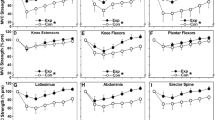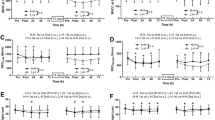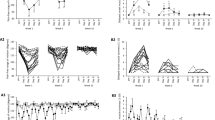Abstract
This study investigated the hypothesis that the protective effect conferred by a low-intensity eccentric exercise against maximal eccentric exercise would not last more than a week. Untrained men (21.3 ± 1.6 years) were allocated into either a control or one of four repeated bout groups (n = 13 per group). The repeated bout groups performed 30 low-intensity eccentric contractions (ECC) of the elbow flexors with a dumbbell set at 10% of maximal isometric strength (10%-ECC) either 2 days, 7 days (1 week), 14 days (2 weeks) or 21 days (3 weeks) before 30 maximal eccentric contractions (Max-ECC). The control group performed Max-ECC only. Changes in maximal voluntary contraction strength, optimum angle, range of motion, upper arm circumference, muscle soreness, plasma creatine kinase activity and myoglobin concentration, and ultrasound echo-intensity following 10%-ECC were analysed by a one-way repeated measures ANOVA. Changes in the variables following Max-ECC were compared among the groups by a two-way repeated measures ANOVA. The 10%-ECC did not change any variables, showing no indication of muscle damage. The changes in all variables following Max-ECC were smaller (P < 0.05) for 2-day, 1- and 2-week groups than control group, without significant differences between 2-day and 1-week groups. The 2-week group showed greater (P < 0.05) changes in all variables compared with 2-day and 1-week groups. Changes in the variables were similar between 3-week and control groups, except for muscle soreness showing smaller (P < 0.05) changes for 3-week group. These results suggest that non-damaging eccentric exercise confers a protective effect against Max-Ecc, but the effect is attenuated between 1 and 2 weeks.





Similar content being viewed by others
References
Barash IA, Peters D, Friden J, Lutz GL, Lieber RL (2002) Desmin cytoskeletal modifications after a bout of eccentric exercise in the rat. Am J Physiol Regul Integr Comp Physiol 283:R958–R963
Beaton LJ, Allen DA, Tarnopolsky MA, Tiidus PM, Phillips SM (2002) Contraction-induced muscle damage is unaffected by vitamin E supplementation. Med Sci Sports Exerc 34:798–805
Black CD, McCully KK (2008) Muscle injury after repeated bouts of voluntary and electrically stimulated exercise. Med Sci Sports Exerc 40:1605–1615
Brockett CL, Morgan DL, Proske U (2001) Human hamstring muscles adapt to eccentric exercise by changing optimum length. Med Sci Sports Exerc 33:783–790
Chen TC, Nosaka K (2006) Responses of elbow flexors to two strenuous eccentric exercise bouts separated by three days. J Strength Cond Res 20:108–116
Chen TC, Nosaka K, Sacco P (2007) Intensity of eccentric exercise, shift of optimum angle and the magnitude of repeated bout effect. J Appl Physiol 102:992–999
Chen TC, Chen HL, Lin MJ, Wu CJ, Nosaka K (2009) Muscle damage responses of the elbow flexors to four maximal eccentric exercise bouts performed every four weeks. Eur J Appl Physiol 106:267–275
Chen TC, Chen HL, Lin MJ, Wu CJ, Nosaka K (2010) Potent protective effect conferred by four bouts of low intensity eccentric exercise. Med Sci Sports Exerc 42:1004–1012
Chen CH, Nosaka K, Chen HL, Lin MJ, Tseng KW, Chen TC (2011) Effects of flexibility training on eccentric exercise-induced muscle damage. Med Sci Sports Exerc 43:491–500
Clarkson PM, Nosaka K, Braun B (1992) Muscle function after exercise-induced muscle damage and rapid adaptation. Med Sci Sports Exerc 24:512–520
Cohen J (1988) Statistical power analysis for the behavioral sciences, 2nd edn. Lawrence Erlbaum Associates, Hillsdale
Crameri RM, Aagaard P, Qvortrup K, Langberg H, Olesen J, Kjaer M (2007) Myofibre damage in human skeletal muscle: effects of electrical stimulation versus voluntary contraction. J Physiol 583:365–380
Hawes MR, Martin AD (2001) Human body composition. In: Eston R, Reilly T (eds) Kinanthropometry and exercise physiology laboratory manual: tests, procedures and data. Routledge, London, pp 42–43
Koh TJ, Brooks SV (2001) Lengthening contractions are not required to induce protection from contraction-induced muscle injury. Am J Physiol Regul Integr Comp Physiol 281:R155–R161
Lapier TK, Burton HW, Almon R, Cerny F (1995) Alterations in intramuscular connective tissue after limb casting affect contraction-induced muscle injury. J Appl Physiol 78:1065–1069
LaRoche DP, Connolly DAJ (2006) Effects of stretching on passive muscle tension and response to eccentric exercise. Am J Sports Med 34:1000–1007
Lavender AP, Nosaka K (2008) A light load eccentric exercise confers protection against a subsequent bout of more demanding eccentric exercise. J Sci Med Sport 11:291–298
McArdle F, Spiers S, Aldemir H et al (2004) Preconditioning of skeletal muscle against contraction-induced damage: the role of adaptations to oxidants in mice. J Physiol 561:233–244
McHugh MP (2003) Recent advances in the understanding of the repeated bout effect: the protective effect against muscle damage from a single bout of eccentric exercise. Scand J Med Sci Sports 13:88–97
Nosaka K, Clarkson PM (1996) Changes in indicators of inflammation after eccentric exercise of the elbow flexors. Med Sci Sports Exerc 28:953–961
Nosaka K, Clarkson PM (1997) Influence of previous concentric exercise on eccentric exercise-induced muscle damage. J Sports Sci 15:477–483
Nosaka K, Newton MJ (2002) Repeated eccentric exercise bouts do not exacerbate muscle damage and repair. J Strength Cond Res 16:117–122
Nosaka K, Sakamoto K, Newton M, Sacco P (2001a) How long does the protective effect on eccentric exercise-induced muscle damage last? Med Sci Sports Exerc 33:1490–1495
Nosaka K, Sakamoto K, Newton M, Sacco P (2001b) The repeated bout effect of reduced-load eccentric exercise on elbow flexor muscle damage. Eur J Appl Physiol 85:34–40
Nosaka K, Newton MJ, Sacco P (2005) Attenuation of protective effect against eccentric exercise-induced muscle damage. Can J Appl Physiol 30:529–542
Nosaka K, Sacco P, Mawatari K (2006) Effects of amino acid supplementation on muscle soreness and damage. Int J Sport Nutr Exerc Metab 16:620–635
Paulsen G, Crameri R, Benstad HB, Fjeld JG, Mørkrid L, Hallén J, Raastad T (2010) Time course of leukocyte accumulation in human muscle after eccentric exercise. Med Sci Sports Exerc 42:75–85
Philippou A, Bogdanis GC, Nevill AM, Maridaki M (2004) Changes in the angle-force curve of human elbow flexors following eccentric and isometric exercise. Eur J Appl Physiol 93:237–244
Proske U, Morgan DL (2001) Muscle damage from eccentric exercise: mechanism, mechanical signs, adaptation and clinical applications. J Physiol 537:333–345
Yu JG, Carlsson L, Thornell LE (2004) Evidence for myofibril remodeling as opposed to myofibril damage in human muscles with DOMS: an ultrastructural and immunoelectron microscopic study. Histochem Cell Biol 121:219–227
Acknowledgments
This research was supported by the National Science Council, Taiwan (NSC97-2410-H-415-036-MY3). The authors would like to thanks Mr. Ming-Ju Lin, Mr. Chung-Hsun Ho, and Miss. Jui-Hsin Lin for their assistance with the data collection and data analysis.
Conflict of interest
None.
Author information
Authors and Affiliations
Corresponding author
Additional information
Communicated by William J. Kraemer.
Rights and permissions
About this article
Cite this article
Chen, HL., Nosaka, K. & Chen, T.C. Muscle damage protection by low-intensity eccentric contractions remains for 2 weeks but not 3 weeks. Eur J Appl Physiol 112, 555–565 (2012). https://doi.org/10.1007/s00421-011-1999-8
Received:
Accepted:
Published:
Issue Date:
DOI: https://doi.org/10.1007/s00421-011-1999-8




